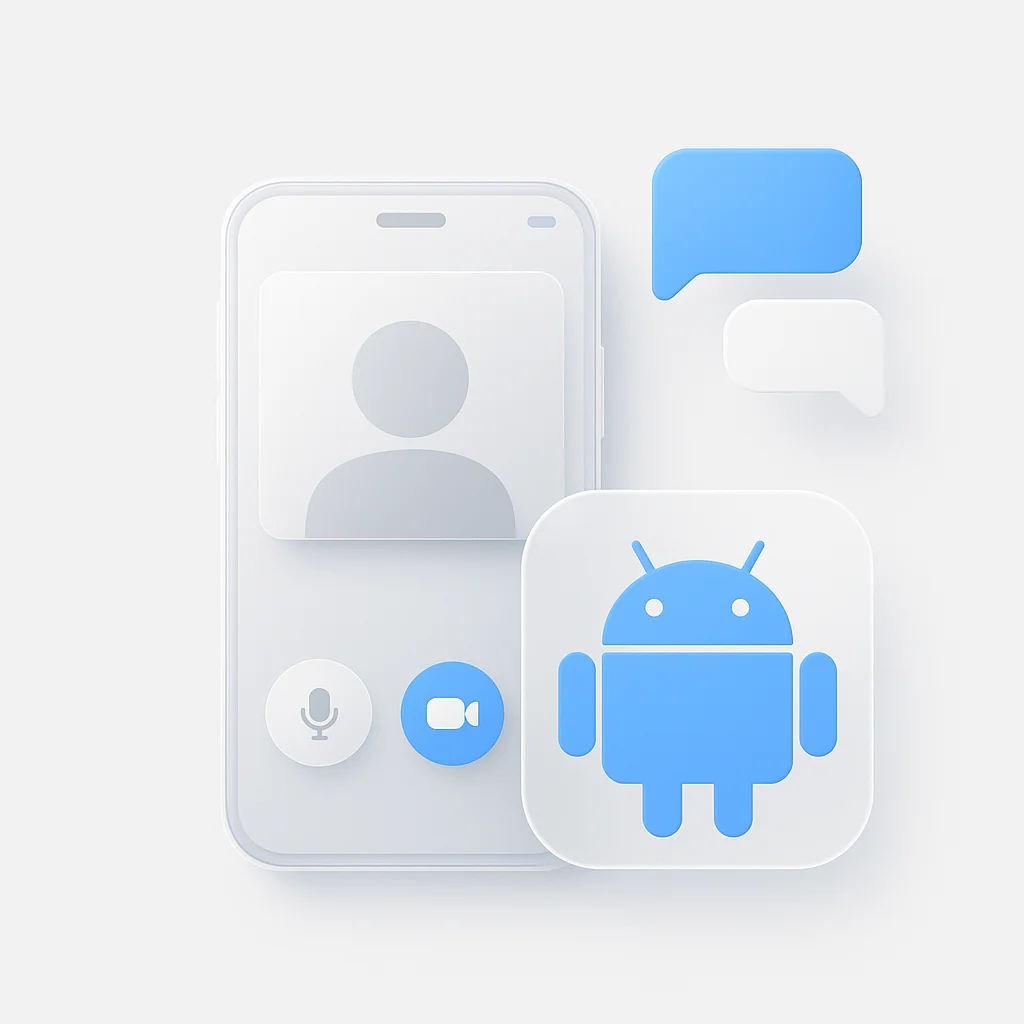Gone are the days of boring, text-heavy slides that put your audience to sleep. AI is revolutionizing the world of presentations, making them more dynamic, engaging, and easier to create than ever before. From brainstorming ideas and generating stunning visuals to summarizing existing videos and even creating AI-powered presenters, these cutting-edge tools are changing the game. Get ready to explore the top AI presentation tools and discover how they can transform your communication skills.
Introduction
Presentations are in the midst of a major transformation, and video is leading the charge. Gone are the days of static slides and droning lectures. In today’s world, it’s all about grabbing attention and keeping audiences engaged. That’s where AI comes in.
Artificial intelligence is revolutionising how we create presentations, making them more dynamic, persuasive, and impactful than ever before. From brainstorming ideas and crafting stunning visuals to full-on video editing, AI-powered tools are taking over the heavy lifting, letting you focus on the core message you want to deliver.
Top Tools at a Glance
| Tool name | Overview | Pros | Cons | Best For | Rating |
|---|---|---|---|---|---|
| ScreenApp Video Summarizer | Streamlines presentation creation by condensing video content. | Time-saving, AI key point identification, customizable. | Relies on source quality, limited creative control. | Sales teams, educators, content creators. | ★★★★☆ |
| Synthesia | Generates video presentations with AI presenters. | Easy to use, presenter choice, customization, multi-language support. | Potential for “Uncanny Valley”, limited control over nuance. | Training modules, explainer videos, global presentations. | ★★★★ |
| Repurpose.io | Transforms long-form video into bite-sized social media-ready presentations. | Content repurposing, workflow automation, templates and customization. | Limited presentation creation, focus on online platforms, limited free features. | Content creators, marketers, individuals looking to automate distribution. | ★★★☆ |
| Descript | All-in-one video/audio editor with AI-features. | Unique editing, integrated screen recording, automatic transcription, studio sound, multi-media support. | Learning curve, limited customization, pricing. | Creating video presentations, editing and polishing recorded presentations. | ★★★★ |
| Visme | Versatile design platform with extensive presentation creation capabilities. | User-friendly interface, variety of templates, interactive elements, data visualization tools, free plan available. | Limited free plan features, steeper learning curve for advanced features, fewer customization options, pricing can be expensive. | Creating professional-looking presentations, teachers, educators, students, small businesses, startups. | ★★★★ |
| Designs.ai | Offers tools specifically for video presentations. | AI-powered design assistance, wide selection of templates, free tier available. | Limited design customization, learning curve for AI features, limited offline functionality. | Creating professional-looking presentations, users new to presentation design, non-designers or small businesses. | ★★★☆ |
| Tome | Storytelling-focused presentation tool. | AI-powered content creation, unique and modern templates, cloud-based and collaborative. | Limited customization options, pricing, newer tool. | Individuals or teams, users who prioritize a clean and modern aesthetic, presenters who value cloud-based access and real-time collaboration. | ★★★☆ |
| Beautiful.ai | Emphasizes design quality and consistency. | AI-powered design, extensive template library, cloud-based collaboration, easy sharing, rich media library. | Limited offline functionality, fewer customization options, pricing structure. | Non-designers, teams, quick presentations. | ★★★★ |
| Lumen5 | Transforms existing content into engaging video presentations. | Ease of use, engaging visuals, text summarization. | Limited design flexibility, video-centric, limited text options. | Short, informative presentations, social media content, non-designers. | ★★★☆ |
| Prequel | Offers AI-powered templates and effects for short video presentations. | Focus on storytelling, engaging design, ease of use, cloud-based. | Limited features, price, learning curve. | Individuals or small teams, presenters who want to stand out, casual presentations. | ★★★☆ |
Top 10 AI Tools
1. ScreenApp Video Summarizer
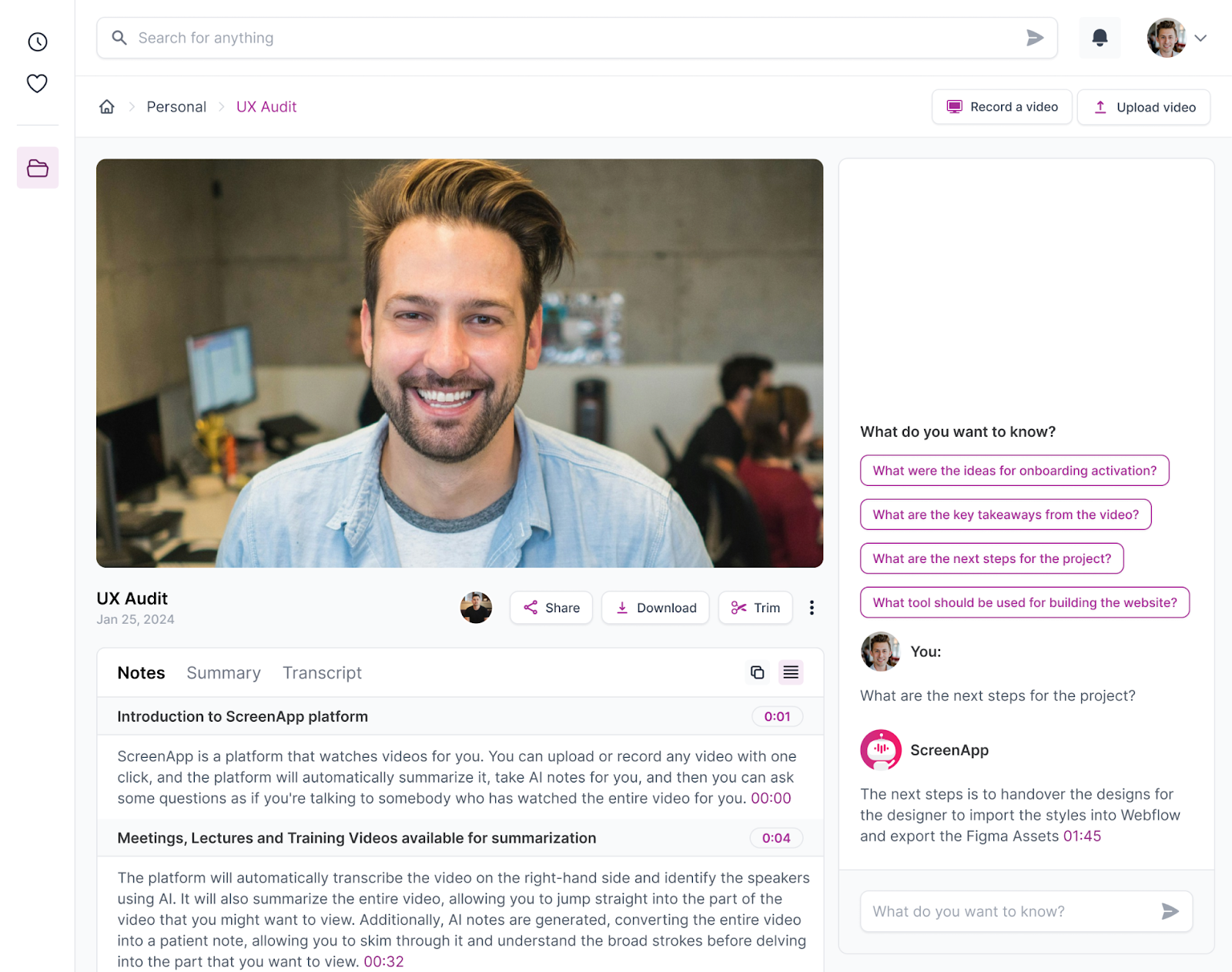
ScreenApp’s Video Summarizer excels at streamlining the presentation creation process by intelligently condensing existing video content. It’s a fantastic way to leverage recordings you already have for more focused, impactful presentations.
Pros:
Time-saving: Drastically reduces time spent manually reviewing and editing videos.
Key Point Identification: AI accurately detects the most important sections of your video material.
Customizable: Control over the summary length and desired presentation style.
Cons:
Reliance on Source Quality: The quality of the summary is tied to the original video clarity and structure.
Limited Creative Control: Best for repurposing, not for creating presentations from scratch.
Best for:
Sales teams repurposing product demos or explainer videos.
Educators extracting key lessons from lectures.
Content creators turning long-form videos into presentation-style recaps.
Rating: 4.5/5
Personal Recommendation: If you frequently work with existing video content and need to turn it into presentations, ScreenApp’s Video Summarizer is an absolute game-changer. Its ability to identify and pull out the core message of a video is surprisingly accurate, saving you valuable time and effort.
2. Synthesia
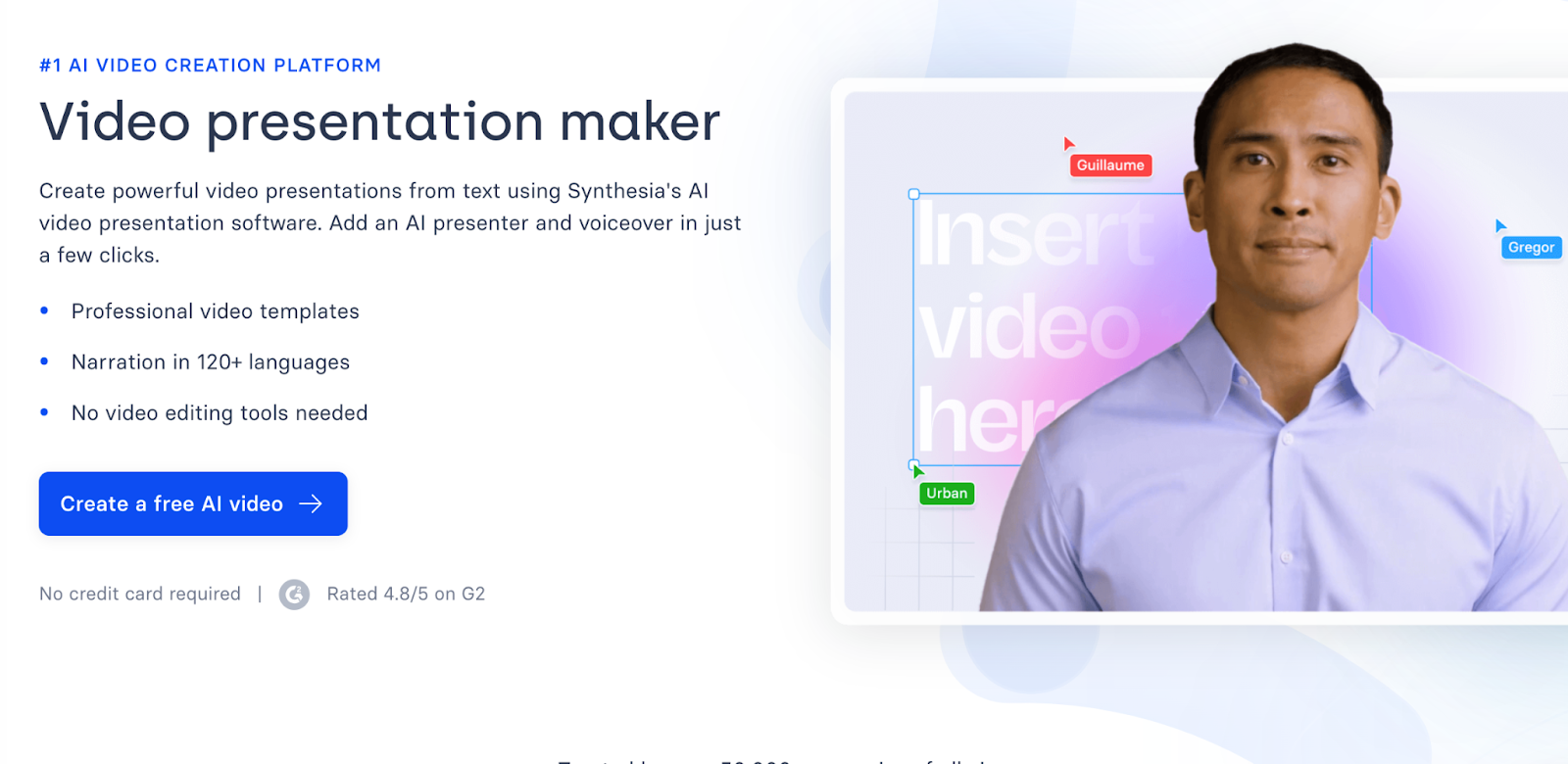
Synthesia lets you generate video presentations with realistic AI presenters simply by providing text. It emphasises customization for a personalised presentation experience.
Pros:
Ease of Use: No video filming or complex editing skills necessary.
Presenter Choice: A wide selection of diverse AI presenters to fit your brand and message.
Customization: Control virtual backgrounds, add images, and incorporate text overlays.
Multi-Language Support: Generate presentations in numerous languages using the text-to-speech feature.
Cons:
Potential for “Uncanny Valley”: Some viewers may find AI presenters slightly unnatural, depending on the level of realism.
Limited Control over Nuance: Fine-tuning delivery and pacing can be challenging compared to a real presenter.
Best for:
Training and e-learning modules where consistent delivery is essential.
Creating personalised explainer videos and internal communications.
Generating presentations in multiple languages for a global audience.
Rating: 4/5
Personal Recommendation: Synthesia is a powerful tool when a video presenter is desired, but time and resources for filming are a constraint. Experimenting with phrasing and delivery styles can mitigate the limitations and produce engaging results.
3. Repurpose.io
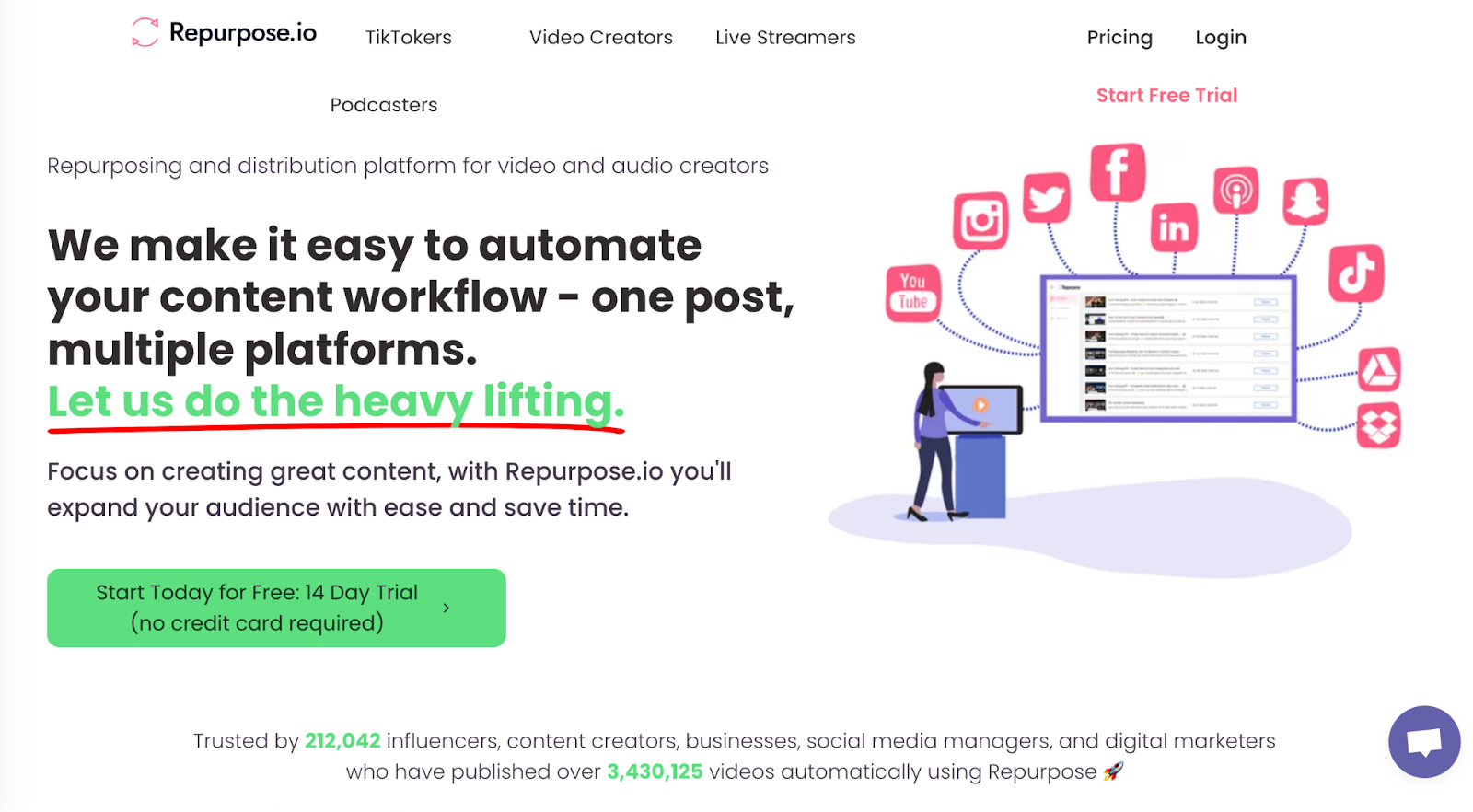
Automatically transform long-form video (webinars, podcasts) into bite-sized social media-ready presentations with key points.
Pros:
Content Repurposing: Repurpose.io shines in repurposing existing content, like videos and podcasts, into various presentation formats like social media posts, blog articles, and email newsletters. This saves time and effort in content creation.
Workflow Automation: Create and automate workflows to distribute your presentation content to multiple platforms, saving you time and ensuring consistent messaging across channels.
Templates and Customization: Utilize pre-built templates for different platforms and customize them with your branding and style.
Cons:
Limited Presentation Creation: Repurpose.io is not a full-fledged presentation creation tool. It excels at repurposing existing content, not building presentations from scratch.
Focus on Online Platforms: The primary focus is repurposing for online platforms like social media, email, and blogs. It may not be ideal for creating traditional slide deck presentations.
Limited Free Features: While it offers a free plan, it has limitations on the number of content pieces you can repurpose.
Best For:
Content creators and marketers who want to repurpose existing video and audio content into various formats for social media, email, and blog marketing.
Individuals looking to automate the distribution of presentation content across multiple online platforms.
Rating: 3.5/5
Personal Recommendation:
Repurpose.io is a valuable tool for content creators and marketers who want to leverage existing content for multi-platform marketing. However, it’s not a replacement for dedicated presentation creation software if your primary need is building presentations from scratch. Consider your specific needs before deciding if Repurpose.io is the right fit for your presentation workflow.
4. Descript
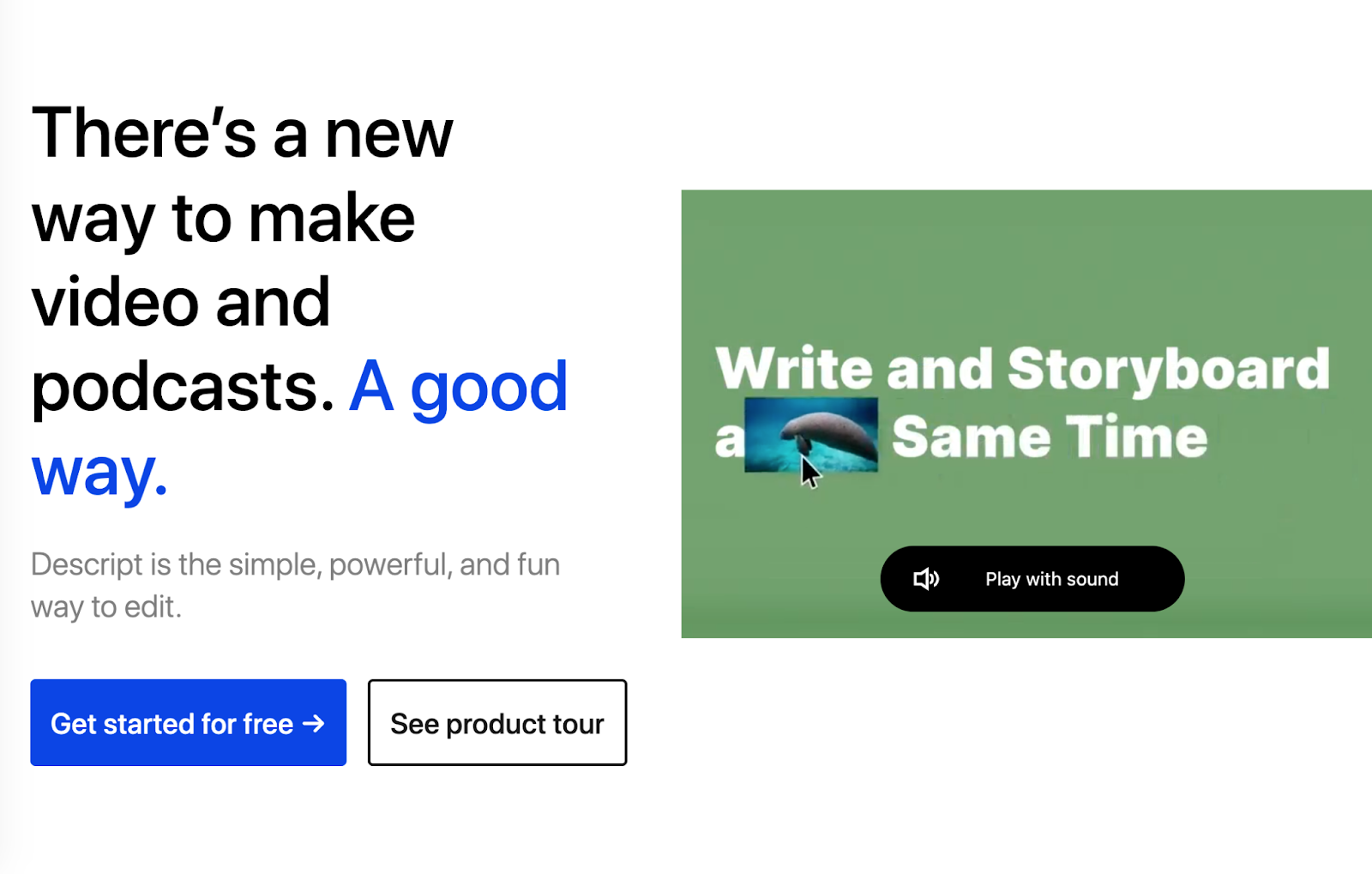
Powerful all-in-one video/audio editor with AI-features like transcript-based editing, background noise removal, and even a ‘filler word’ remover.
Pros:
Unique Editing: Edit your videos by editing the transcript, allowing for easy removal of filler words, stumbles, and re-recording specific sections.
Integrated Screen Recording: Capture your screen and presentations directly within Descript.
Automatic Transcription: Saves time with an accurate automatic transcription of your recordings.
Studio Sound: Enhance your audio quality with background noise removal and other adjustments.
Multi-media Support: Combine slides, images, videos, and audio into a single project.
Cons:
Learning Curve: The interface can be slightly complex compared to basic presentation tools.
Limited Customization: Templates and design options are not as extensive as dedicated presentation software.
Pricing: Free tier has limitations, and paid plans can be expensive for light use.
Best For:
Creating video presentations from existing slides or scripts.
Editing and polishing recorded presentations.
Individual creators focused on engaging and polished presentations.
Rating: 4/5
Personal Recommendation:
Descript is a powerful tool for creating and editing video presentations, offering unique features and a streamlined workflow. However, it might have a steeper learning curve and lack the extensive design customization of dedicated presentation software. Consider your needs and budget before deciding.
If you prioritize editing flexibility and a unique workflow for video presentations, Descript is a great choice. If you need highly customizable slides and a simpler interface, traditional presentation tools might be a better fit.
5. Visme
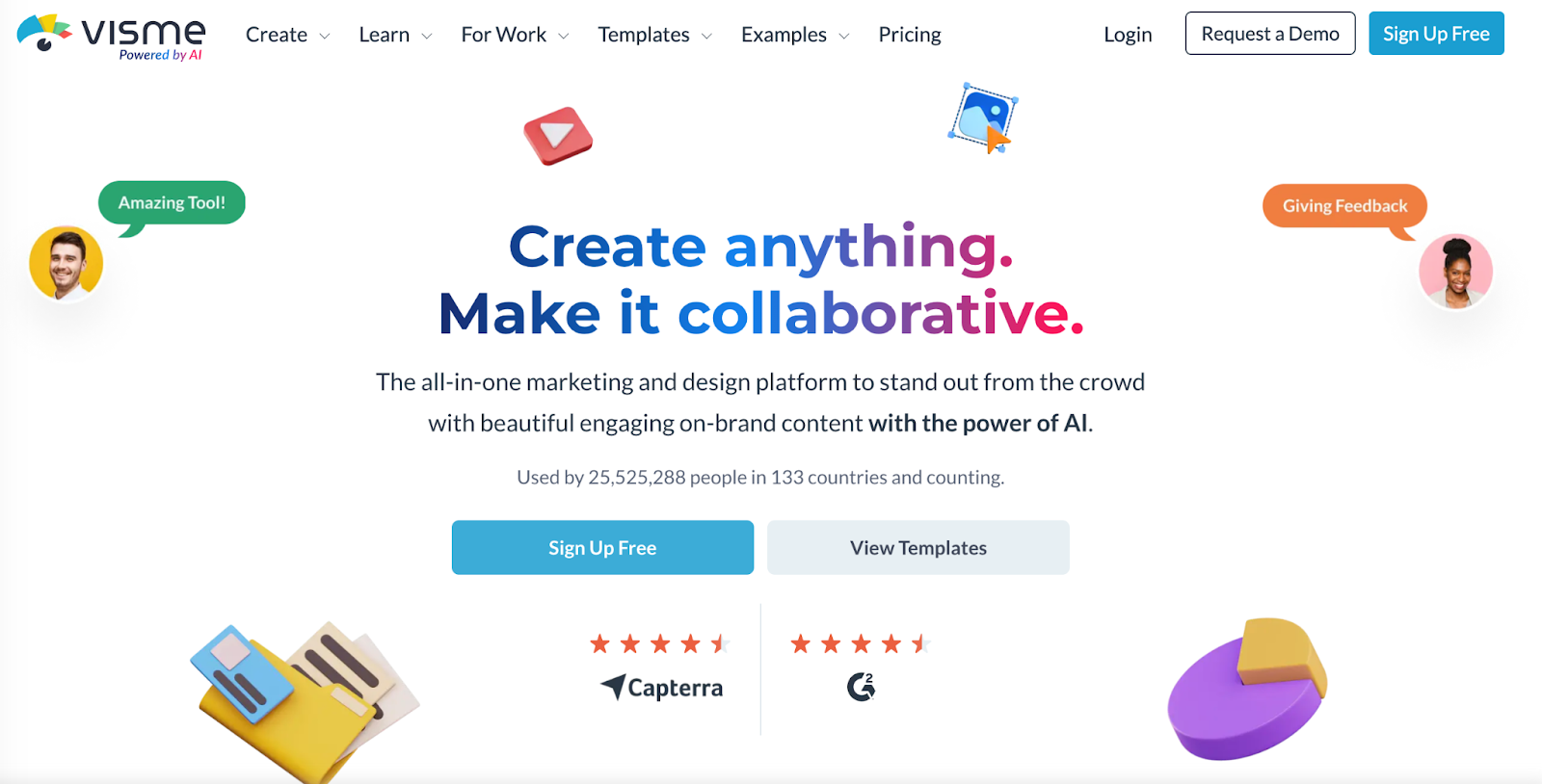
Versatile design platform with extensive presentation creation capabilities. AI helps suggest layouts, visuals, and can even generate entire slides based on text.
Pros:
User-friendly interface: Easy to learn and use, even for beginners.
Wide variety of templates and themes: Saves time and ensures a professional look.
Interactive elements: Makes presentations more engaging and memorable.
Data visualization tools: Helps turn data into clear and understandable visuals.
Free plan available: Great for casual users or creating a few presentations.
Cons:
Limited free plan features: Watermarks, limited storage, and exports.
Steeper learning curve for advanced features: Animations, interactivity, etc.
Fewer customization options compared to some competitors: May not be ideal for highly specific design needs.
Pricing can be expensive for larger teams or frequent use: Requires careful consideration.
Best for:
Creating professional-looking presentations quickly and easily.
Teachers, educators, and students.
Small businesses and startups.
Creating presentations with interactive elements.
Rating: 4/5
Personal recommendation:
Visme is a great option for anyone who wants to create professional-looking presentations without a lot of hassle. The user-friendly interface, wide variety of templates, and free plan make it a good choice for beginners. However, if you need a lot of customization options or are on a tight budget, there may be better options available.
6. Designs.ai
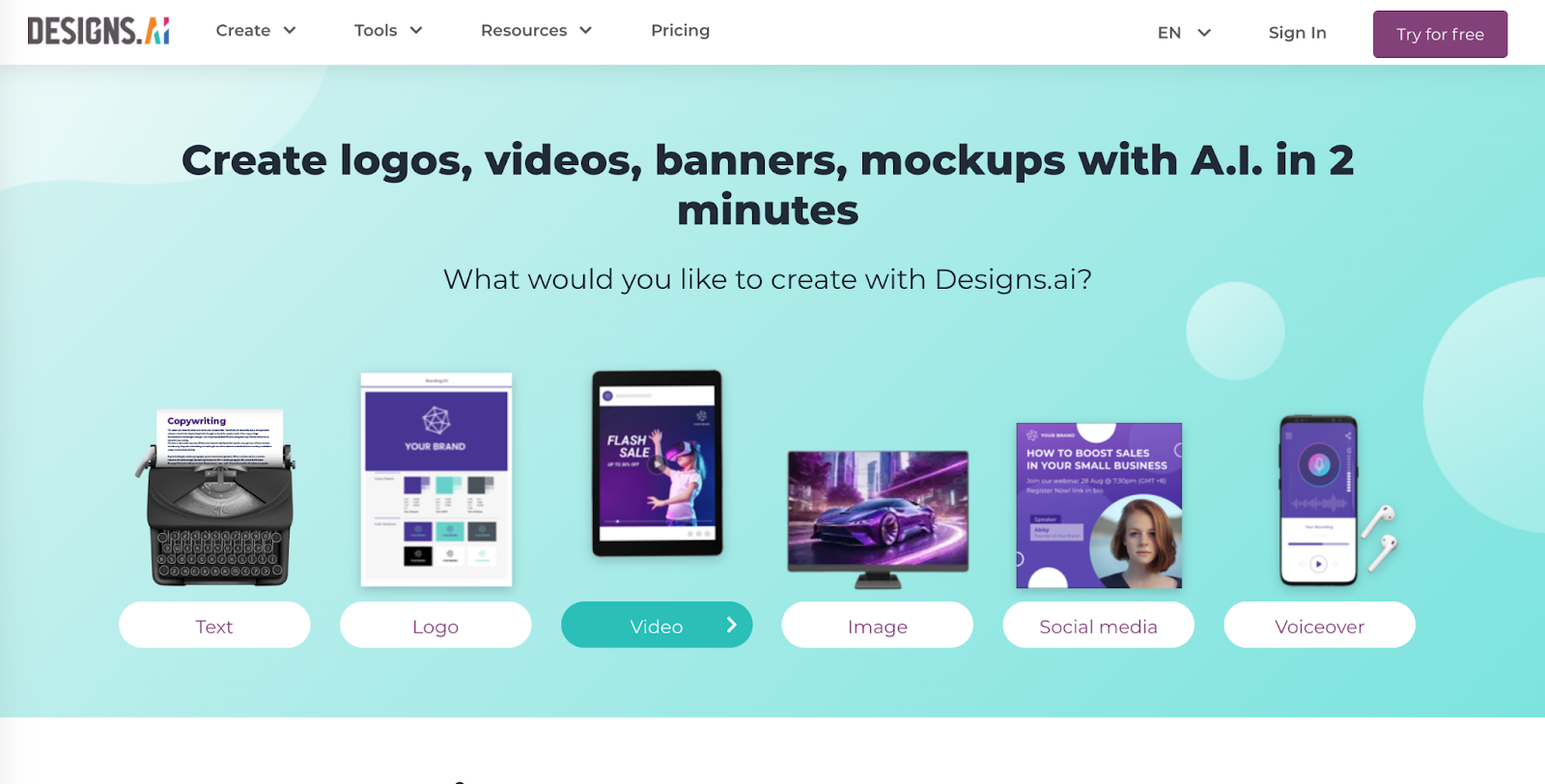
Offers tools specifically for video presentations, including text-to-video generation, stock footage libraries, and AI-powered design assistance.
Pros:
AI-powered design assistance: Designs.ai offers features like auto-generated layouts, smart resizing, and content suggestions to streamline the design process and save time.
Wide selection of templates: Choose from a vast library of pre-designed templates for various presentation types, saving you the work of starting from scratch.
Free tier available: Unlike some competitors, Designs.ai offers a free plan with basic features, making it accessible to casual users.
Cons:
Limited design customization: Compared to traditional presentation tools, Designs.ai might offer less flexibility for highly customized or complex presentations.
Learning curve for AI features: While AI assists in design, understanding its capabilities and limitations might require some exploration.
Limited offline functionality: Primarily web-based, Designs.ai may have limited features when used offline.
Best for:
Creating professional-looking presentations quickly and easily.
Users new to presentation design who want AI assistance.
Non-designers or small businesses needing a quick and affordable solution.
Rating: 3.5/5
Personal recommendation:
Designs.ai is a good option for those looking for a user-friendly and AI-powered tool to create visually appealing presentations quickly. However, it may not be ideal for users requiring extensive customization or offline functionality. If design flexibility and precise control are your top priorities, exploring traditional presentation software like Microsoft PowerPoint or Google Slides might be better.
It’s recommended to try both Designs.ai and other options to see which best suits your needs and preferences.
7. Tome
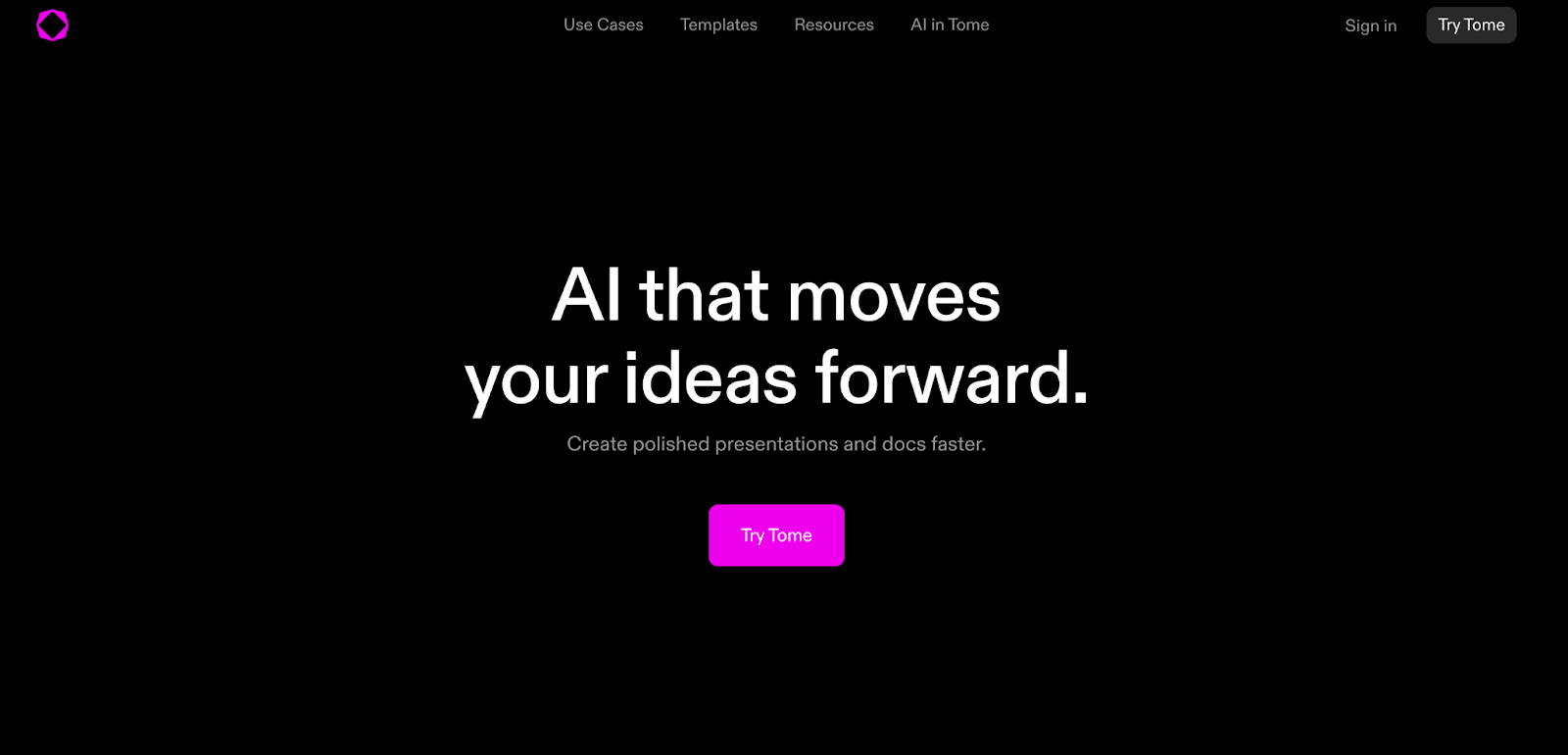
Storytelling-focused presentation tool. AI helps generate full narratives and beautiful slide layouts from a simple outline.
Pros:
AI-powered content creation: Tome uses AI to suggest text, images, and video based on your topic, helping you create presentations faster and potentially with more engaging content.
Unique and modern templates: Tome offers a variety of pre-designed templates with a focus on modern and minimalist aesthetics, which can help your presentations stand out.
Cloud-based and collaborative: You can access and edit your presentations from any device with internet access, and collaborate with others in real-time.
Cons:
Limited customization options: While Tome offers templates, the level of customization for individual elements within slides might be lower compared to traditional presentation tools.
Pricing: Tome’s free plan has limited features, and paid plans can be more expensive than some competitors.
Newer tool: As a relatively new tool, Tome might have fewer integrations and functionalities compared to established presentation software.
Best for:
Individuals or teams who want to create presentations quickly and easily with the help of AI.
Users who prioritize a clean and modern aesthetic for their presentations.
Presenters who value cloud-based access and real-time collaboration.
Rating: 3.5/5
Personal Recommendation:
Tome can be a valuable tool for specific needs, but it’s important to weigh the pros and cons. If you prioritize speed, ease of use, and a modern aesthetic, and are comfortable with a limited customization range, Tome could be a good fit. However, if you need a high degree of customization, advanced features, or find the pricing unappealing, other presentation tools might be better suited.
It’s recommended to try Tome’s free plan or explore alternative tools like Google Slides, Canva, or Microsoft PowerPoint before making a decision.
8. Beautiful.ai
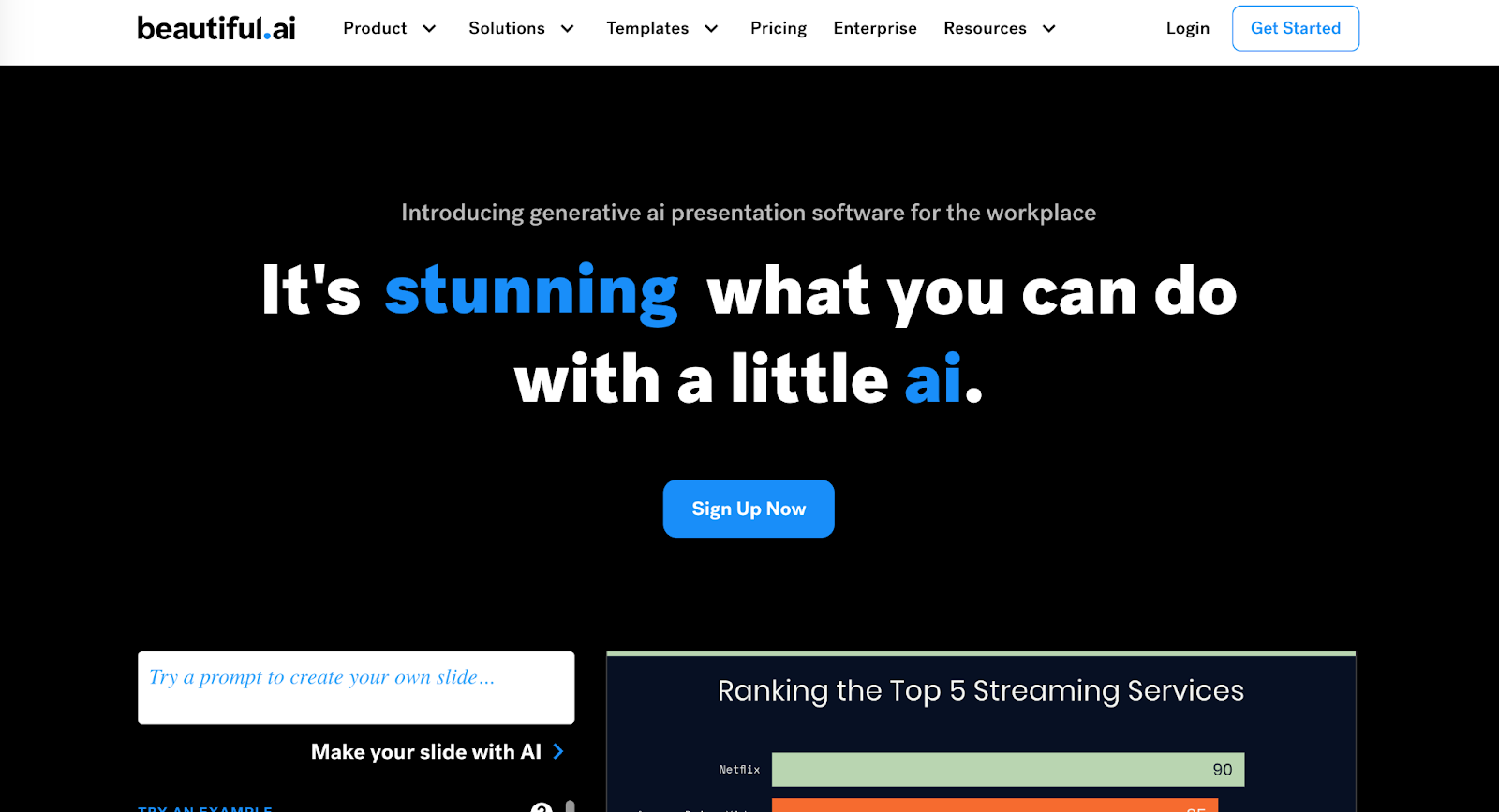
Emphasizes design quality and consistency. AI assists with slide layouts, suggesting visuals that perfectly match your content.
Pros:
AI-powered design: Automatically adjusts layouts, fonts, and colors for a polished look, even with minimal design skills.
Extensive template library: Offers a variety of pre-designed templates for various purposes, saving you time and effort.
Cloud-based collaboration: Allows real-time editing and feedback sharing with teammates.
Easy sharing: Share presentations via link, embed on websites, or export for offline use.
Rich media library: Includes millions of free photos and icons, and supports video integration.
Cons:
Limited offline functionality: Editing features are primarily available online.
Fewer customization options compared to some competitors: May not offer the same level of granular control for highly specific design needs.
Pricing structure: Free plan has limited features, paid plans can be expensive for individual users.
Best For:
Non-designers: Users who lack design expertise but want to create professional-looking presentations.
Teams: Collaborative presentations and easy sharing between team members.
Quick presentations: Creating presentations quickly with the help of pre-designed templates and AI-assisted design.
Rating: 4/5
Personal Recommendation:
Beautiful.ai is a strong option for individuals and teams who prioritize ease of use, collaboration, and professional design aesthetics. However, users with advanced design needs or those on a tight budget might find other presentation tools more suitable. It’s worth trying the free plan to see if it meets your needs before committing to a paid subscription.
9. Lumen5
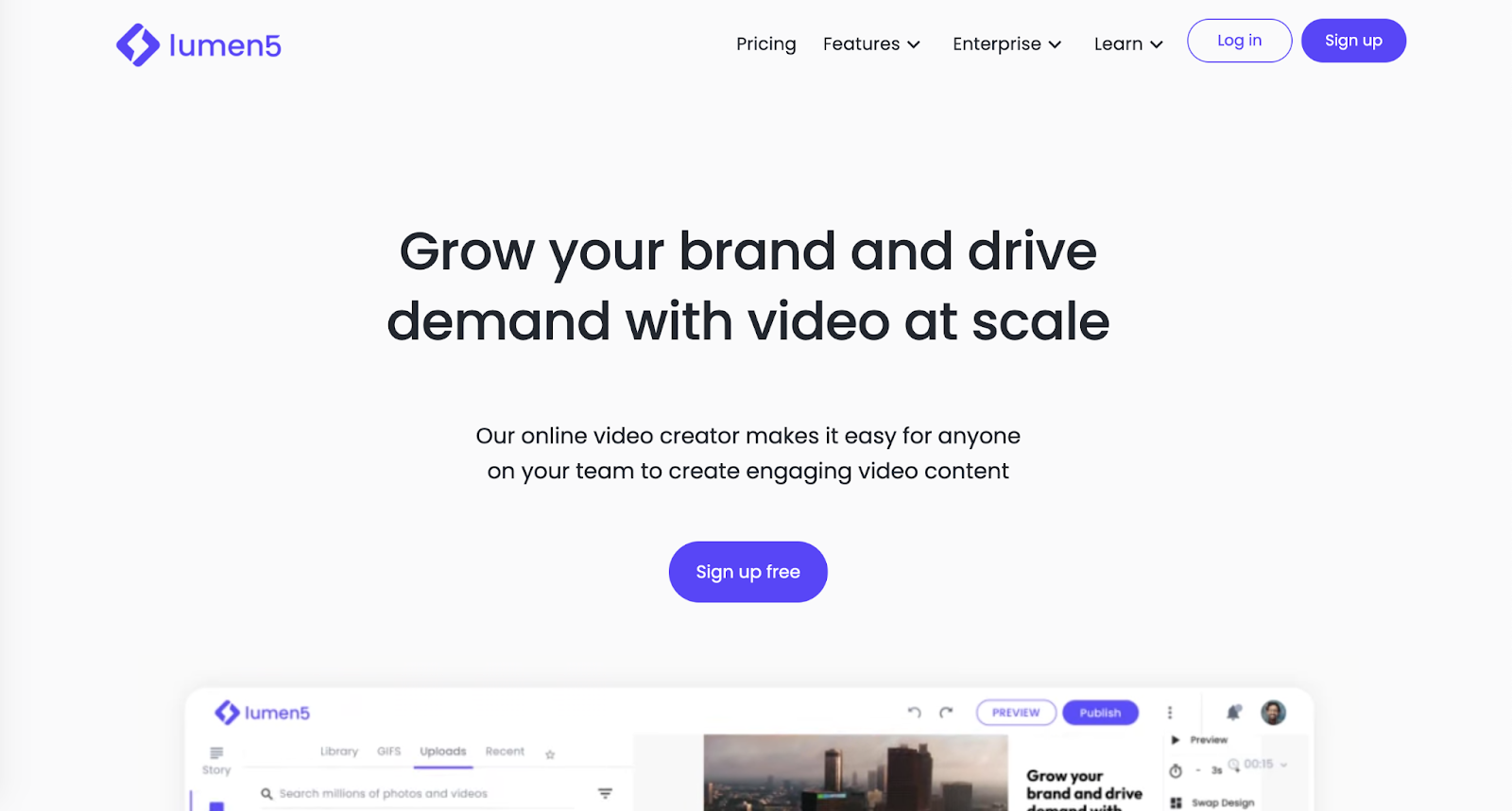
Specializes in transforming existing content (like blog articles) into engaging video presentations. Great for repurposing.
Pros:
Ease of use: Lumen5’s AI-powered platform allows anyone to create video presentations quickly and easily, even without design experience.
Engaging visuals: The platform provides access to a library of stock videos, images, and music, allowing for the creation of visually appealing presentations.
Text summarization: Lumen5 can automatically summarize existing text content, saving time and effort.
Cons:
Limited design flexibility: Compared to dedicated presentation tools like PowerPoint or Google Slides, Lumen5 offers less control over the overall design and layout of the presentation.
Video-centric: Lumen5 primarily creates video presentations, which may not be suitable for all situations.
Limited text options: While text can be added to Lumen5 presentations, the options for formatting and customization are limited.
Best For:
Short, informative presentations: Lumen5 excels at creating concise and engaging presentations for explaining concepts, sharing data, or promoting products/services.
Social media content: Video presentations created with Lumen5 are well-suited for sharing on social media platforms like Facebook, Instagram, and Twitter.
Non-designers: If you lack design experience or need to create a presentation quickly, Lumen5 can be a valuable tool.
Rating: 3.5/5
Personal Recommendation:
While not a replacement for traditional presentation tools, Lumen5 can be a valuable addition to your presentation toolkit. Its ease of use and engaging visuals make it a good option for specific situations, particularly creating short, visually-driven presentations for online audiences. However, for presentations requiring more complex layouts, extensive text, or specific design elements, dedicated presentation software might be a better choice.
10. Prequel
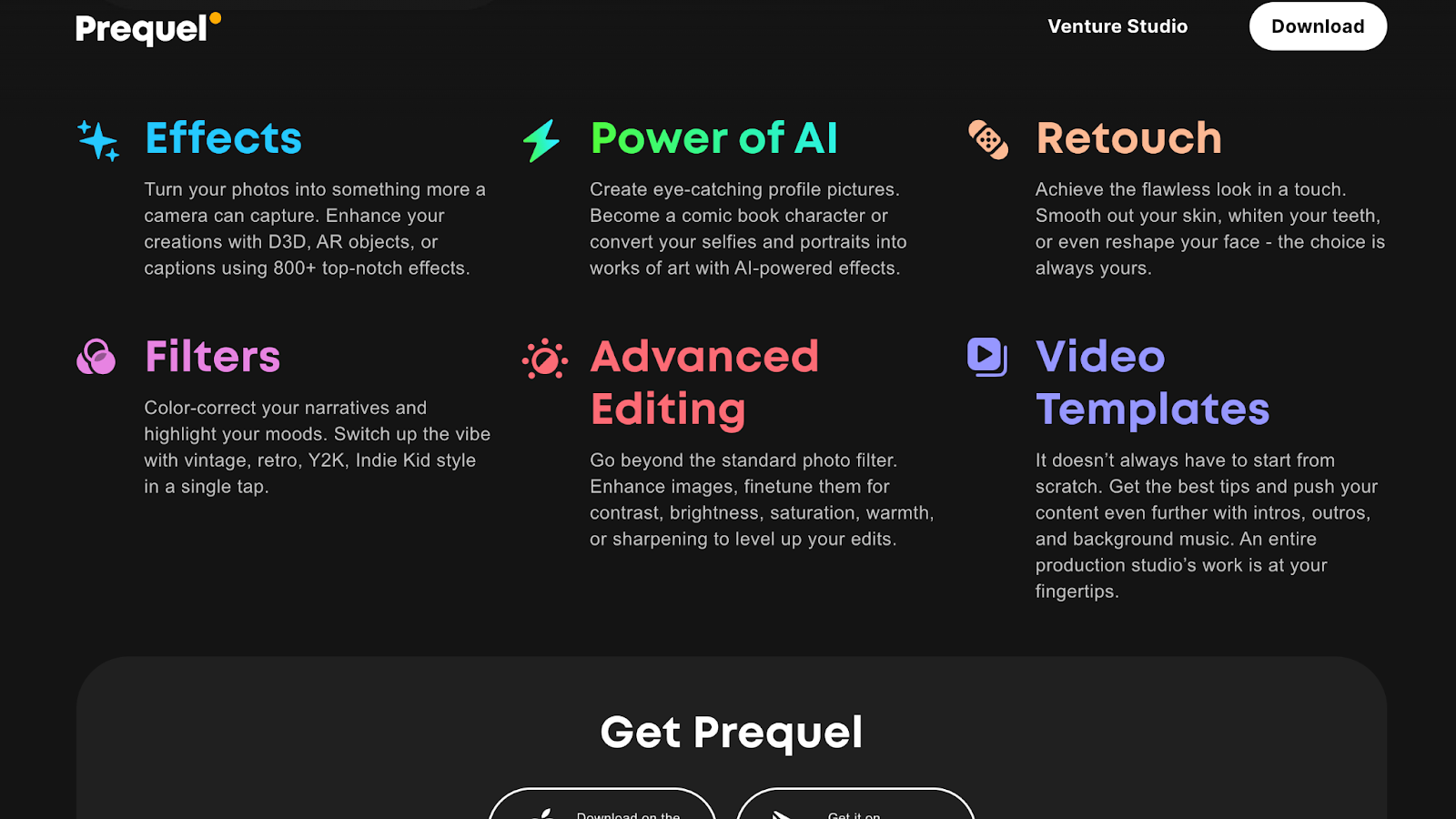
Offers AI-powered templates and effects to easily create short, visually stunning video presentations, aimed at social media impact.
Pros:
Focus on storytelling: Prequel prioritizes clear and concise storytelling through its minimal design and focus on large visuals.
Engaging design: Offers unique features like cinematic transitions and parallax scrolling for visually impactful presentations.
Ease of use: User-friendly interface with drag-and-drop functionality makes creating presentations intuitive and fast.
Cloud-based: Access and collaborate on presentations from any device with an internet connection.
Cons:
Limited features: Lacks some functionalities found in traditional presentation tools, like complex animations or numerous slide layouts.
Price: Prequel offers a free plan with limited features, paid plans can be expensive compared to alternatives.
Learning curve: While user-friendly, the unique interface might require some initial familiarization compared to familiar presentation tools.
Best for:
Individuals or small teams creating visually engaging presentations with a focus on storytelling and design.
Presenters who want to stand out from traditional, text-heavy presentations.
Casual presentations, pitches, product demos, or quick updates.
Rating: 3.5/5
Personal recommendation:
Prequel is a great option for individuals and small teams who prioritize impactful visual storytelling over extensive features. Its user-friendliness and engaging design make it a good choice for casual presentations or those seeking to stand out. However, its limited features and cost might not be suitable for complex presentations or those needing extensive functionalities.
The Benefits of Video in Presentations
Presentations have often gotten a bad reputation – dry, text-heavy slides delivered in a monotone voice can easily leave audiences bored and disengaged. Video offers a powerful solution to this challenge. Here’s why incorporating video into your presentations is a game-changer:
Increased Engagement and Information Retention: The human brain is wired to process visuals far more efficiently than text. Studies have shown that audiences are more likely to stay focused and remember key messages when presented visually through video content.
Better Emotional Connection and Storytelling Potential: Video doesn’t just convey information; it has the power to evoke emotions. Through a compelling story, dynamic visuals, music, or even just the human element of a presenter, video can create a deeper connection with your audience and make your message resonate.
Versatility – Use for Sales, Training, Marketing, etc.: The applications for video presentations are endless. A sales team can use product demo videos, customer testimonials, or personalized pitches. Training modules can incorporate screencasts and instructional videos. And marketers can leverage explainer videos or social media-friendly clips. The adaptability of video makes it a valuable asset in numerous contexts.
Challenges and Considerations
AI presentation tools offer exciting possibilities, but there are some factors to consider. While some tools require a higher upfront cost, especially for advanced features, others might have a learning curve for accessing all functionalities. Additionally, ethical considerations like transparency of AI use, potential biases in the technology, and ensuring original content are crucial aspects to keep in mind for responsible and effective presentations.
Conclusion
The way we present information is constantly changing, and AI is playing a major role in this evolution. Don’t be left behind – try one of these presentation tools to see how they can enhance your communication skills. These tools streamline the presentation creation process, offering suggestions and clever design elements to make your work stand out. Remember, staying up-to-date with the latest technology is always a good idea, and this is a great way to do so!
Frequently Asked Questions
Q: Are AI presentation tools expensive?
A: The cost of AI presentation tools varies greatly. Some offer basic features for free, while more advanced platforms come with subscription fees. It’s important to compare features and pricing models to find a tool that fits your budget and needs.
Q: Can I use AI presentation tools if I’m not tech-savvy?
A: Many AI presentation tools are designed with user-friendliness in mind. Look for platforms that offer drag-and-drop interfaces, templates, and tutorials to help you get started, even if you have limited technical experience.
Q: Will AI tools replace the need for human presenters?
A: While AI presenters are becoming increasingly sophisticated, they are unlikely to fully replace human presenters. AI presenters excel at delivering consistent, pre-scripted information. However, the ability to improvise, handle unexpected questions, and connect with an audience on a personal level remain strengths of human presenters.
Q: Do AI presentation tools ensure my content is original?
A: It’s important to use AI tools responsibly. Always verify that the content generated (scripts, visuals) is not plagiarizing existing work. Many tools include built-in features to check for originality or integrate with plagiarism checkers.
Q: Can I customize the output from AI presentation tools?
A: Yes, the level of customization varies between tools. Most allow you to add your own branding, text overlays, and images to personalize the result. Some offer more granular control over elements like editing video clips or fine-tuning an AI presenter’s voice.
Q: How do I choose the right AI presentation tool for my needs?
A: Consider these factors before making your decision:
Type of presentations you create: Sales, marketing, training, etc.
Your comfort level with technology: Do you need simplicity or advanced features?
Budget: Free vs. paid options
Specific features: Video editing, AI presenters, slide design assistance, etc.
For those looking to create professional presentations efficiently, AI presentation tools can transform your workflow from concept to final delivery.



